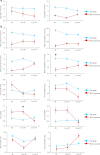Dynamic changes of region-specific cortical features and scalp-to-cortex distance: implications for transcranial current stimulation modeling
- PMID: 33397402
- PMCID: PMC7784346
- DOI: 10.1186/s12984-020-00764-5
Dynamic changes of region-specific cortical features and scalp-to-cortex distance: implications for transcranial current stimulation modeling
Abstract
Background: Transcranial current stimulation in rehabilitation is a fast-growing field featured with computational and biophysical modeling. Cortical features and scalp-to-cortex distance (SCD) are key variables for determining the strength and distribution of the electric field, yet longitudinal studies able to capture these dynamic changes are missing. We sought to investigate and quantify the ageing effect on the morphometry and SCD of left primary motor cortex (M1) and dorsolateral prefrontal cortex (DLPFC) in normal ageing adults and mild cognitive impairment (MCI) converters.
Methods: Baseline, 1-year and 3-year follow-up structural magnetic resonance imaging scans from normal ageing adults (n = 32), and MCI converters (n = 22) were drawn from the Open Access Series of Imaging Studies. We quantified the changes of the cortical features and SCDs of left M1 and DLPFC, including grey matter volume, white matter volume, cortical thickness, and folding. Head model was developed to simulate the impact of SCD on the electric field induced by transcranial current stimulation.
Results: Pronounced ageing effect was found on the SCD of left DLPFC in MCI converters. The SCD change of left DLPFC from baseline to 3-year follow-up demonstrated better performance to discriminate MCI converters from normal ageing adults than the other morphometric measures. The strength of electric field was consequently decreased with SCD in MCI converters.
Conclusion: Ageing has a prominent, but differential effect on the region-specific SCD and cortical features in older adults with cognitive impairments. Our findings suggest that SCD, cortical thickness, and folding of the targeted regions could be used as valuable imaging markers when conducting transcranial brain stimulation in individuals with brain atrophy.
Keywords: Ageing; Brain stimulation; Cortical folding; DLPFC; Modeling; Scalp-to-cortex distance.
Conflict of interest statement
The authors declare that they have no competing interests.
Figures




Similar articles
-
Localized Analysis of Normalized Distance from Scalp to Cortex and Personalized Evaluation (LANDSCAPE): Focusing on Age- and Dementia-Specific Changes.J Alzheimers Dis. 2019;67(4):1331-1341. doi: 10.3233/JAD-180732. J Alzheimers Dis. 2019. PMID: 30689573
-
Scalp-to-cortex distance of left primary motor cortex and its computational head model: Implications for personalized neuromodulation.CNS Neurosci Ther. 2019 Nov;25(11):1270-1276. doi: 10.1111/cns.13204. Epub 2019 Aug 16. CNS Neurosci Ther. 2019. PMID: 31420949 Free PMC article.
-
Decoding the radiomic features of dorsolateral prefrontal cortex in individuals with accelerated cortical changes: implications for personalized transcranial magnetic stimulation.J Med Imaging (Bellingham). 2023 Jan;10(1):015001. doi: 10.1117/1.JMI.10.1.015001. Epub 2023 Jan 4. J Med Imaging (Bellingham). 2023. PMID: 36619873 Free PMC article.
-
Factors to consider when applying transcranial magnetic stimulation of dorsolateral prefrontal cortex when resting motor threshold is asymmetric: A case study.Bioelectromagnetics. 2016 Feb;37(2):130-5. doi: 10.1002/bem.21955. Epub 2016 Feb 11. Bioelectromagnetics. 2016. PMID: 26866631
-
Changes in the cortical GABAergic inhibitory system with ageing and ageing-related neurodegenerative diseases.J Physiol. 2024 Dec 25. doi: 10.1113/JP285656. Online ahead of print. J Physiol. 2024. PMID: 39722574 Review.
Cited by
-
Electric Field Modeling in Personalizing Transcranial Magnetic Stimulation Interventions.Biol Psychiatry. 2024 Mar 15;95(6):494-501. doi: 10.1016/j.biopsych.2023.11.022. Epub 2023 Dec 5. Biol Psychiatry. 2024. PMID: 38061463 Free PMC article. Review.
-
MRI-informed machine learning-driven brain age models for classifying mild cognitive impairment converters.J Cent Nerv Syst Dis. 2024 Jul 21;16:11795735241266556. doi: 10.1177/11795735241266556. eCollection 2024. J Cent Nerv Syst Dis. 2024. PMID: 39049837 Free PMC article.
-
Differences in scalp-to-cortex tissues across age groups, sexes and brain regions: Implications for neuroimaging and brain stimulation techniques.Neurobiol Aging. 2024 Jun;138:45-62. doi: 10.1016/j.neurobiolaging.2024.02.011. Epub 2024 Feb 29. Neurobiol Aging. 2024. PMID: 38531217 Free PMC article.
-
Radiomics-Informed Modeling for Transcranial Ultrasound Stimulation: Age Matters.Front Neurosci. 2022 Jun 15;16:935283. doi: 10.3389/fnins.2022.935283. eCollection 2022. Front Neurosci. 2022. PMID: 35784843 Free PMC article. No abstract available.
-
Clinical and radiomic features for predicting the treatment response of repetitive transcranial magnetic stimulation in major neurocognitive disorder: Results from a randomized controlled trial.Hum Brain Mapp. 2022 Dec 15;43(18):5579-5592. doi: 10.1002/hbm.26032. Epub 2022 Aug 1. Hum Brain Mapp. 2022. PMID: 35912517 Free PMC article. Clinical Trial.
References
Publication types
MeSH terms
Grants and funding
LinkOut - more resources
Full Text Sources
Other Literature Sources
Medical

